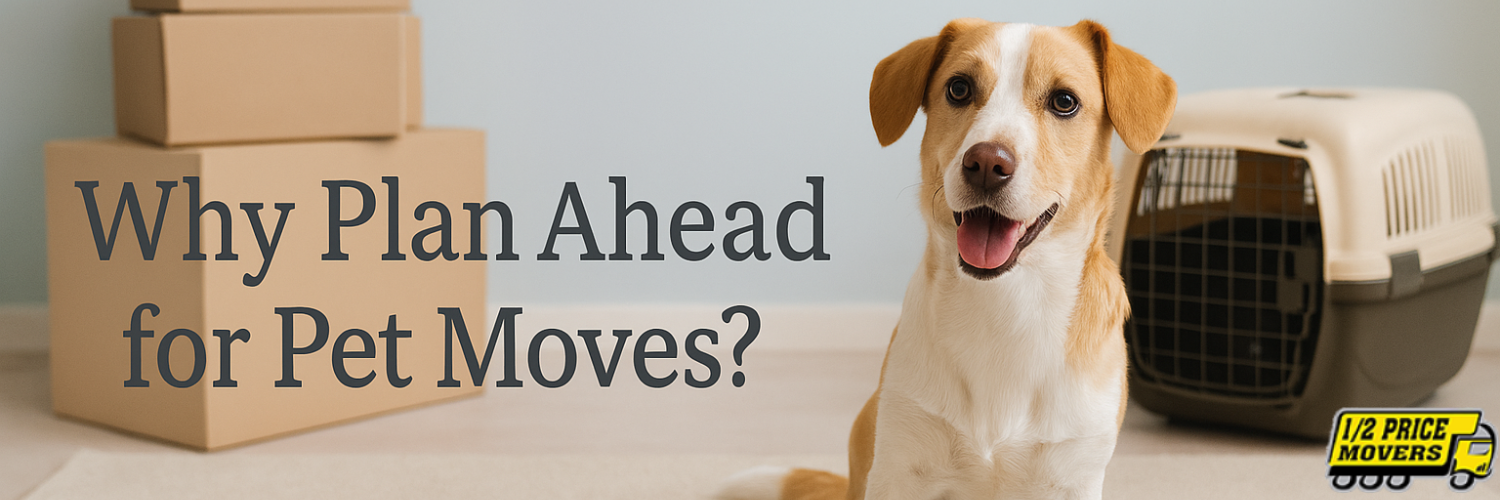Moving with Pets: Tips to Keep Your Furry Friends Comfortable
Moving can bring forth stress distributions, not to mention the needs of the furry family members. Pets need routine and get stressed with all the changes accompanying a move. The extra adjustment to a different space and the upset in their daily routines can cause anxiety in animals. Anyway, planning and preparation can bring in a smooth move for you and your little fur babies. A few additional steps do help your pet down the road, whether your move is just around the corner or somewhere across the country.
For those looking for the best movers in NYC, selecting a moving company that understands the complexities of relocating with pets, such as packing and securing transport for your pets, is essential!
Why Early Preparation Is Crucial for Moving with Pets?

The sooner you start planning, the easier it will be for the animals to settle comfortably in their new homes. Animals can quite sensitively respond to an environment and will pick up on changes; if some thought is given to planning ahead, the logistics of moving with the animals will become easier. Here are the basic steps to prepare your pet for the move.
- Veterinary Visit: First of all, make sure you get your pet checked up by a vet—or at least try to have it done around 4-6 weeks before your moving day. This is to ensure that your pet is healthy and has all its vaccinations updated. If you are traveling to another state or abroad, ask your veterinarian for any health certificates or travel documents.
- Identification: Update your pet’s tag and microchip, and have it carry the new address or phone number. This is very important in case your pet somehow manages to get out during the move.
- Travel: Just like you, a pet needs to be ready for the journey to a new home. If flying or traveling long-distance, get an assured comfy crate and allow your pet to get familiar with it. This provides security for the animal come moving day.
- Packing materials: Start packing early, and allow pets to get used to boxes and packing materials within the house. So, the moving process won’t feel strange to them.
Maintaining a Sense of Normalcy During the Move
Moving with pets is a stressful process to go through, but it is achievable when their routine is taken into account. The familiar an animal’s routine is, the more comforting it is to them. Having the scheduled feeding time also helps maintain stability and structure, which is essential for them. Along with routine feeding, daily walks, and energetic play sessions must also take place to keep the energetic pets calm during the moving chaos. Pack some of your pet’s comfort items, which include blankets, beds, and toys. Other pets, such as cats, benefit more from such items as they provide a feeling of safety. Having all these factors taken into account makes your pet’s transition easy.
Moving Day Tips: Keeping Pets Safe and Calm
On moving day, emotions are rife, so calm any pet that enters the arena. Extra care is needed in moving with a pet for its safety and serenity during transit. Here are a few tips for making the day pleasant for your four-legged friend, whether traveling by car or by airplane:
- Food and water: Pack enough food and water to last the journey. If it’s a long trip, pack a travel water bottle that is used at any rest stop.
- Secure crate or carrier: Ensure that the crate is of the right size for your pet, has ample ventilation, and is very sturdy for traveling. The animal is guaranteed sufficient room to stand up, turn around, and lie down comfortably.
- Health records and documents: Keep a copy of medical records, vaccination history, and any required travel certificates close to you in hand. This is very necessary when crossing State or International borders.
- Leash and harness: Even if your pet will be traveling in a crate, always have a leash and harness available for bathroom breaks and stretches.
Travel Tips for Moving with a Pet

Animals can be sensitive and can be affected by changes in their environments. The life-changing things that happen when you pack your stuff, moving trucks everywhere, and new or unfamiliar places can be stressful to your animals. Traveling with pets? Here are some simple moving with pets tips to relieve some of the stress for your animals!
- Avoid feeding just before traveling: To avoid nausea, do not feed your pet a full meal immediately before moving.
- Ensure your pet is secure: In either a crate or with a pet seatbelt harness, always ensure your pet is securely in the vehicle to prevent distractions.
- Minimize stress: Keep your pet away from the commotion during the moving process. If at all possible, ask a trusted friend or family member to care for them in a quiet room until travel time.
Should You Use a Pet Moving Service for Long-Distance Relocation?

Relocations from one state to another or across international boundaries are vast and complicated. Consider hiring a pet relocation agenc and mobving pet services costto simplify the process. This organization essentially saw to it that pets were safely transported and, well, what else? These moving companies specialize in the movement of animals, ensuring that all travel arrangements are made to get the pet safely to its final destination. They take care of everything for you: from arranging flights and other methods of transportation to ensuring your pet’s safe delivery. They will also take care of the medical papers for all your pets, such as vaccination records and health certificates; all other papers required by your destination need to be completed as well. In addition, senders will be supplied with a travel crate specifically designed for pets that complies with all airline requirements so that the pet will be safe, secure, and comfortable during transport. They would monitor your pet throughout the travel, giving you great comfort and peace of mind that the animal is being looked after well, and especially so should you embark on a longer journey, especially abroad. Leaving it to a professional agency means not just making it easier on yourself, but on your pet, too, and giving them that stress-free, safe journey.
Watch for Post-Move Stress Signals in Pets
The stress signs may establish themselves at any time during the phase of adaptation. Moving with pets, either going without a moving firm or having one, can certainly be distressing to the animal, and a bit of post-moving panic may very well be among the accepted horrors of any move. Some symptoms are:
- Loss of appetite: The animal loses interest in food due to stress and tends to eat less. Using different types of food could be encouraged to keep the animal eating.
- Clinginess or hiding: The animal may want to stick with you or may want to just go hide in some corner of the new house, seeking reassurance and consolation.
- Restlessness or pacing: Some animals may be bewildered and wish to check the new environment as a way of adaptation. To ease pressure, put on some soft music that they would probably find relaxing, or apply some approved pheromone gels.
- Accidents indoors: If the pet was housebroken but recently started to have accidents indoors, it may be a sign of anxiety. No need to panic; just go back to proper training and have some patience.
You should therefore consult your vet if it goes on for longer than a couple of weeks.
Frequently Asked Questions About Moving with Pets
Moving can be challenging, but moving with pets can be even more complicated. However, you can make moving with a pet easier by preparing in advance. When it comes to moving your pet long-distance or internationally, you might want to consider a pet moving service – they will manage the difficult and complicated logistics and keep your pet safe during their journey.
Absolutely! Crate training is especially important and highly recommended for moving with a pet. Crate training will allow your pet to travel in a safer, more comfortable environment while feeling secure and calm throughout the journey
The key factor in moving with a pet is consistency. Keep as much of your packing/incidental routine the same as possible, give lots of encouragement, and set up a familiar and cozy space where your pet can have time to settle in and relax. In a short time, they will become familiar with their surroundings. With either pheromone wipes or a pheromone spray. Indoor accidents: If your house-trained pet is having indoor accidents, this can often be a sign of anxiety. The good news is that this phase will pass, so keep taking them out and be patient. If, after some time, you still feel overwhelmed or your pet has not changed or improved at a pace you want, please speak with your veterinarian to rule out any health concerns.
Final Thoughts: Moving with Pets Requires Care and Planning
A little preparation can go a long way toward making a smooth and easy transition to your new home. With planning, you can reduce any anxiety you (or your pet) may experience when making a change in their routine. Although there will be additional stressors when moving with a pet, whether it be across the street or to another country, you can get through it! Suppose you are in search of the best movers in NYC. In that case, you’ll want to make sure to find a company that will understand dealing with the extras that you will have in the moving process and that can deal with other fragile items if you happen to have special items like musical instruments or fine art.
Give us a call today at (718) 689-0556 or fill out the form so we can help you find movers for your move. We want to make your transition seamless.

